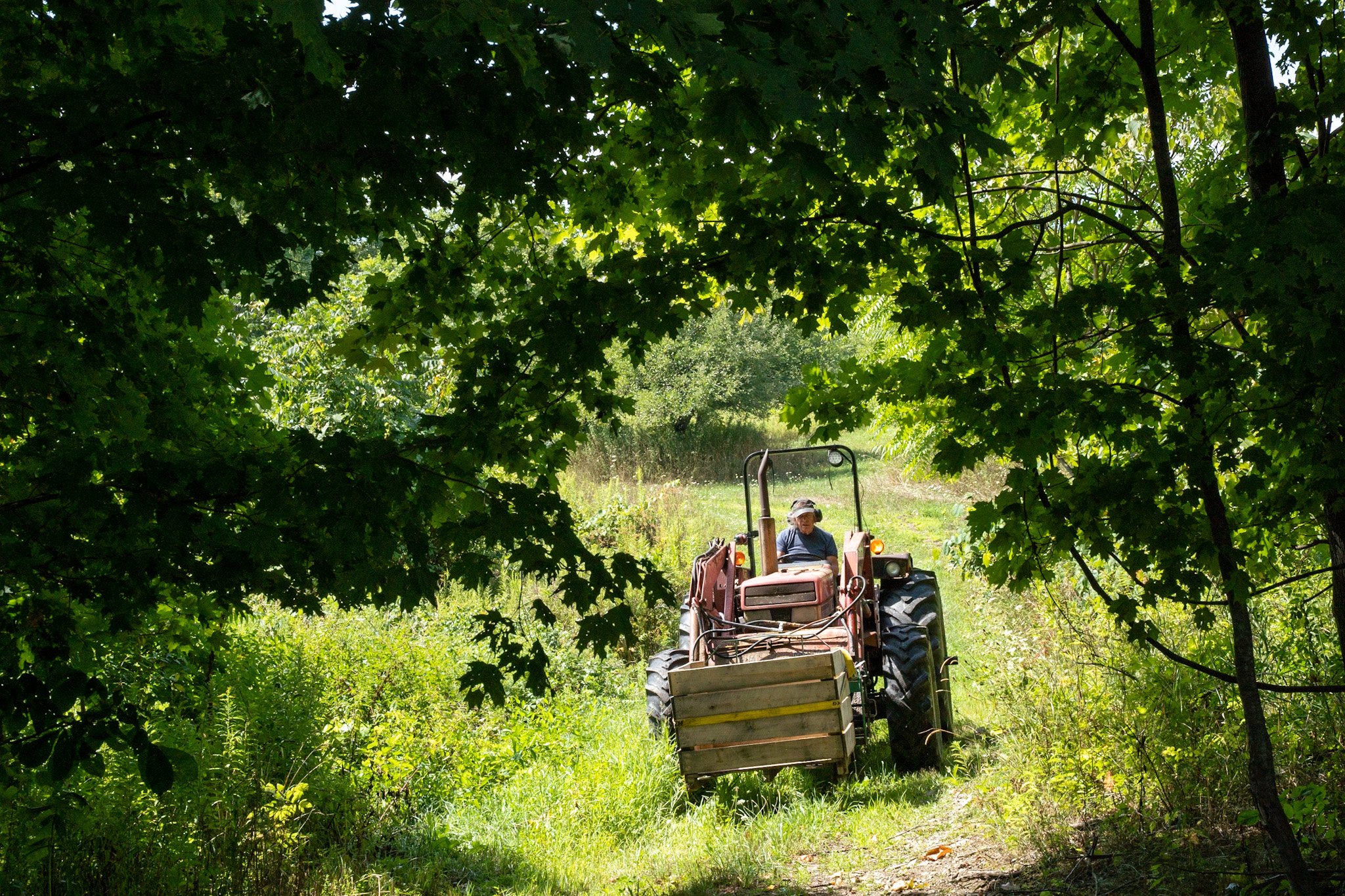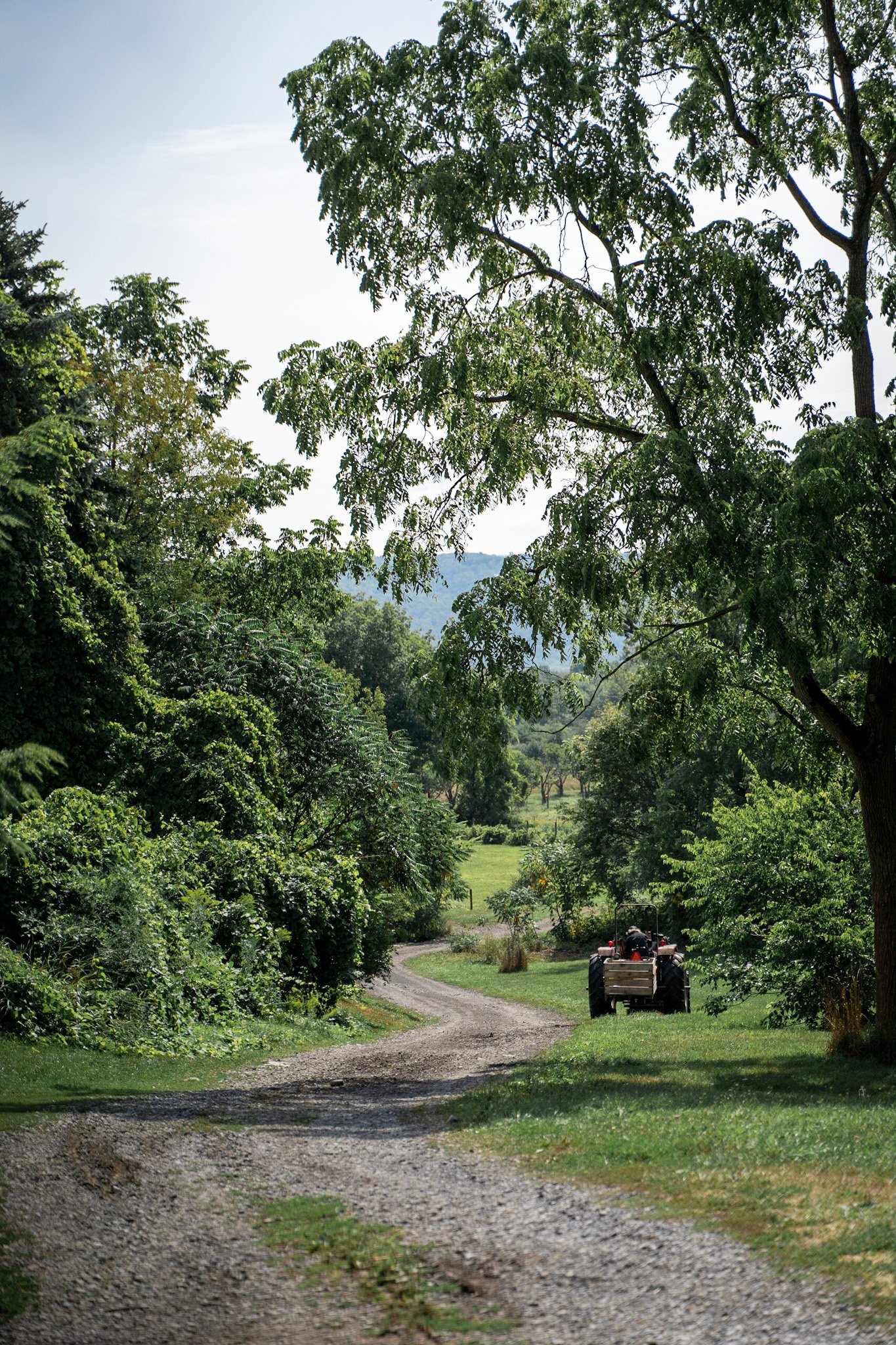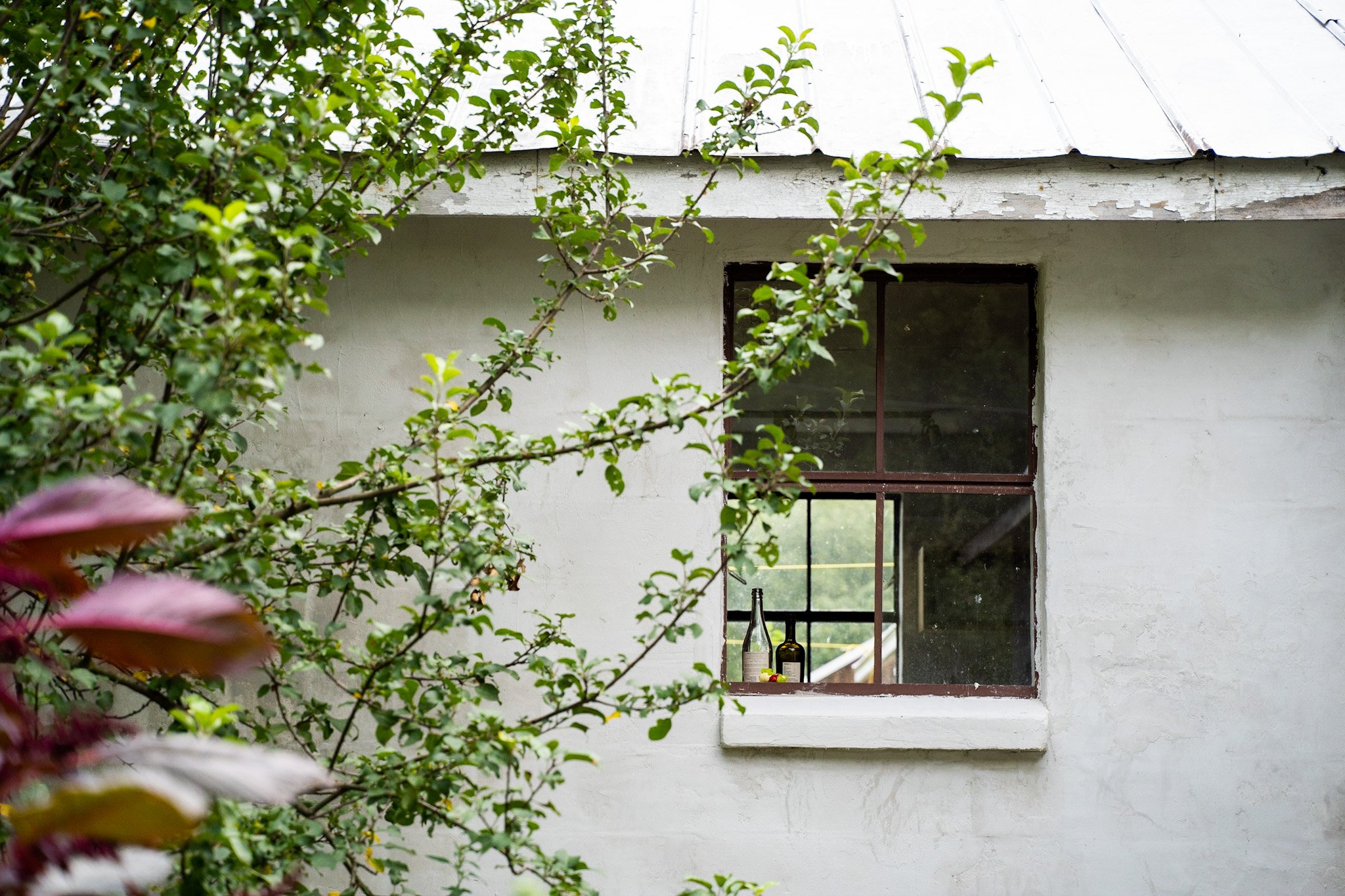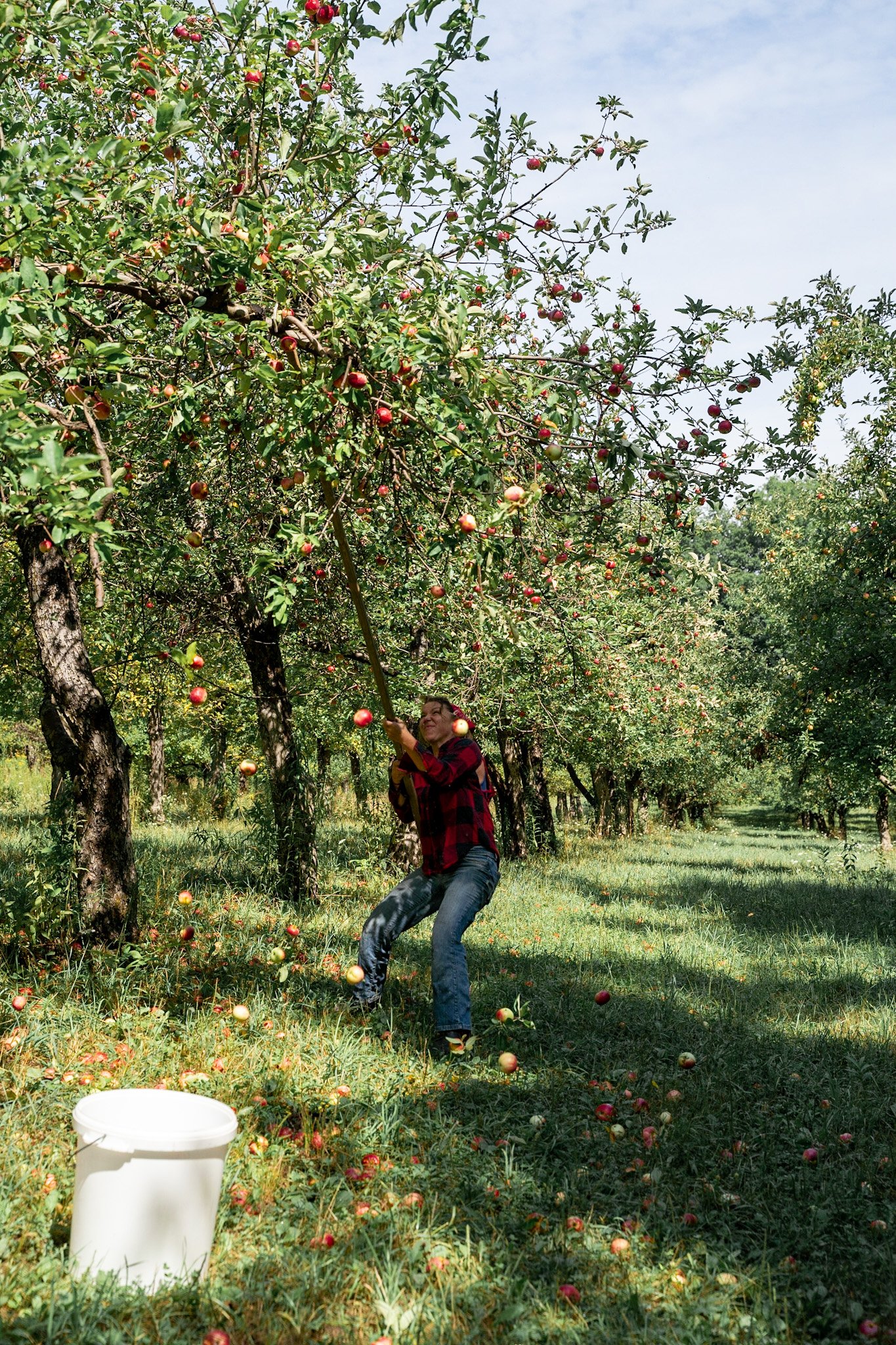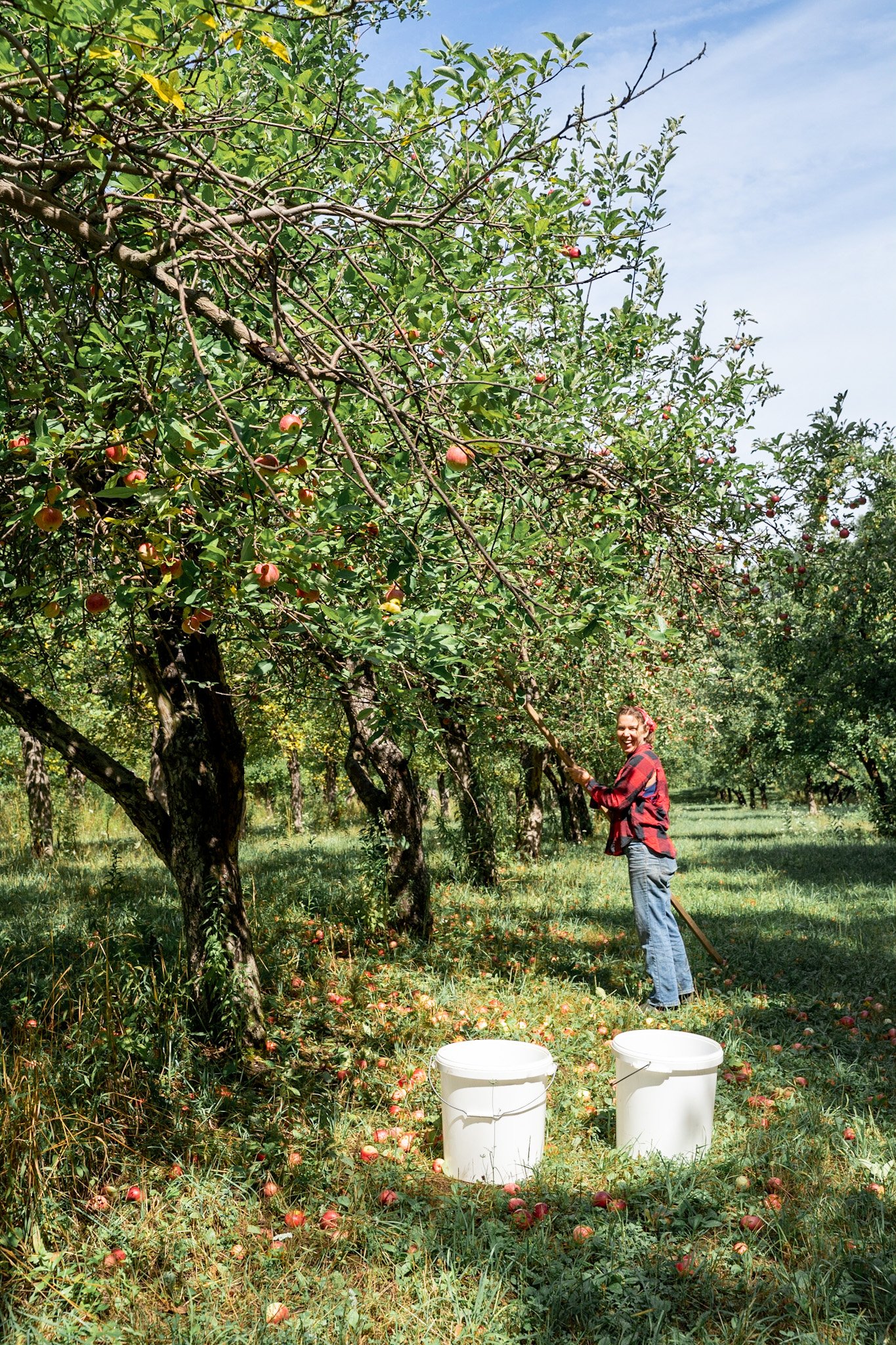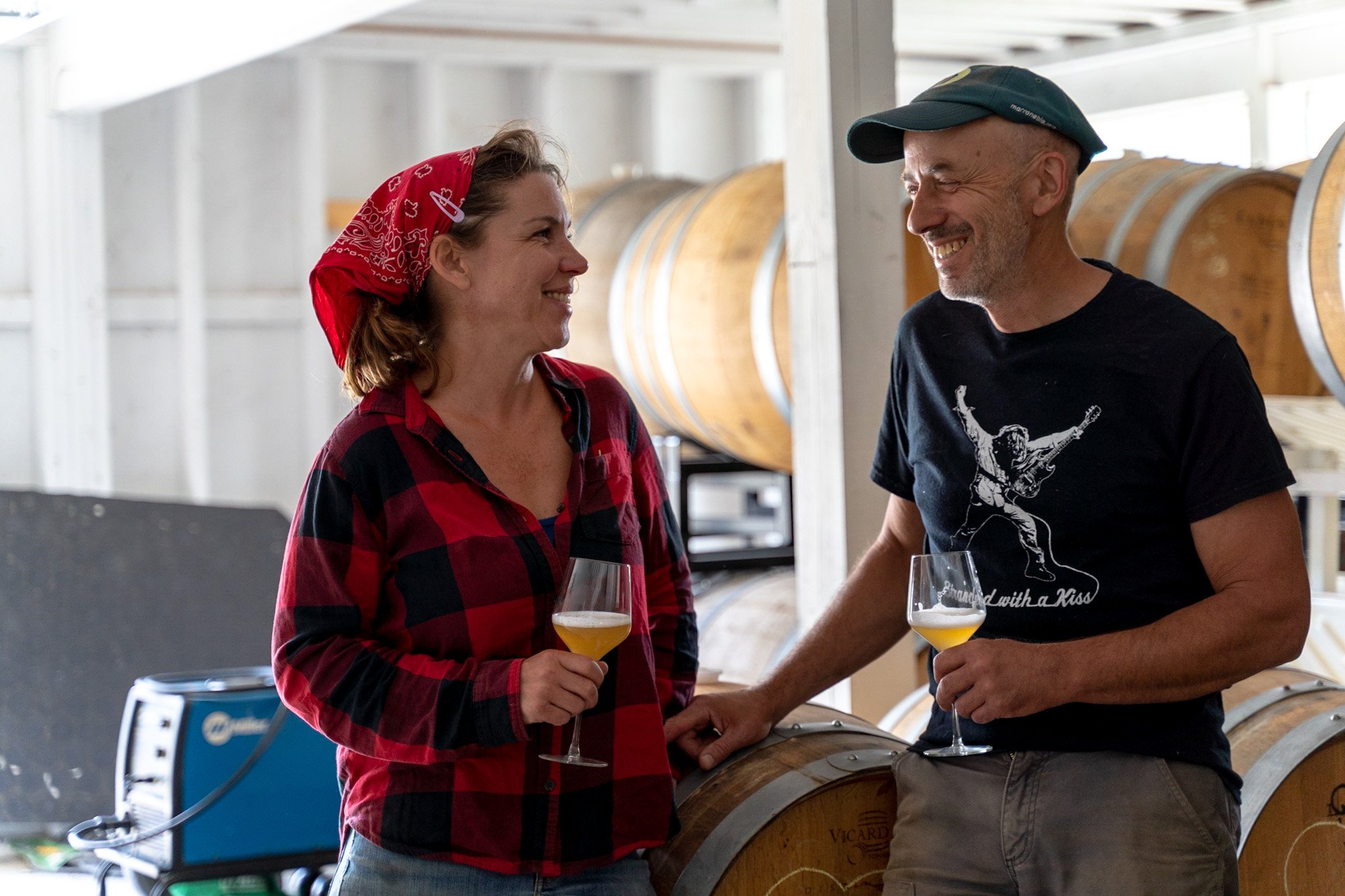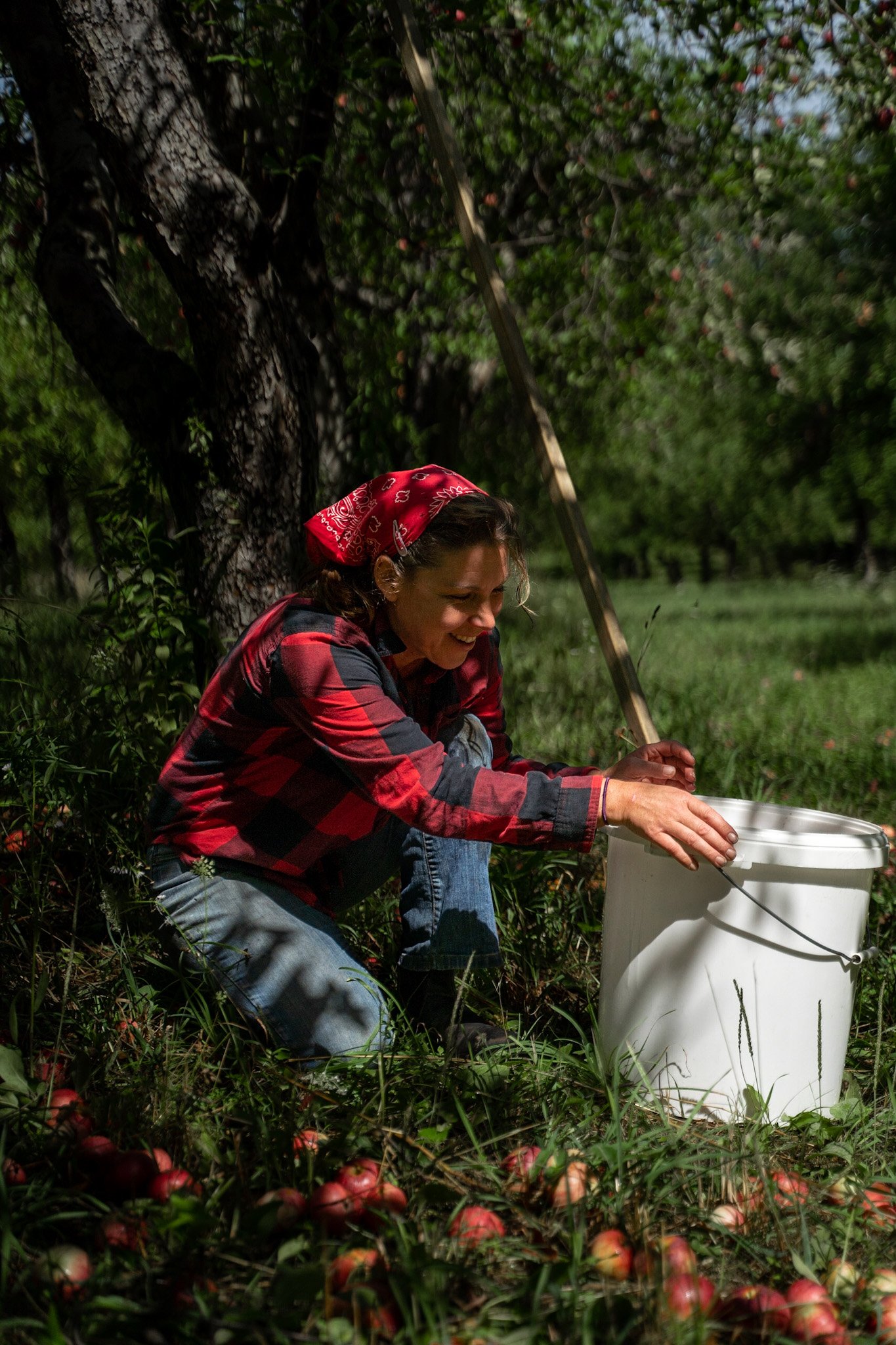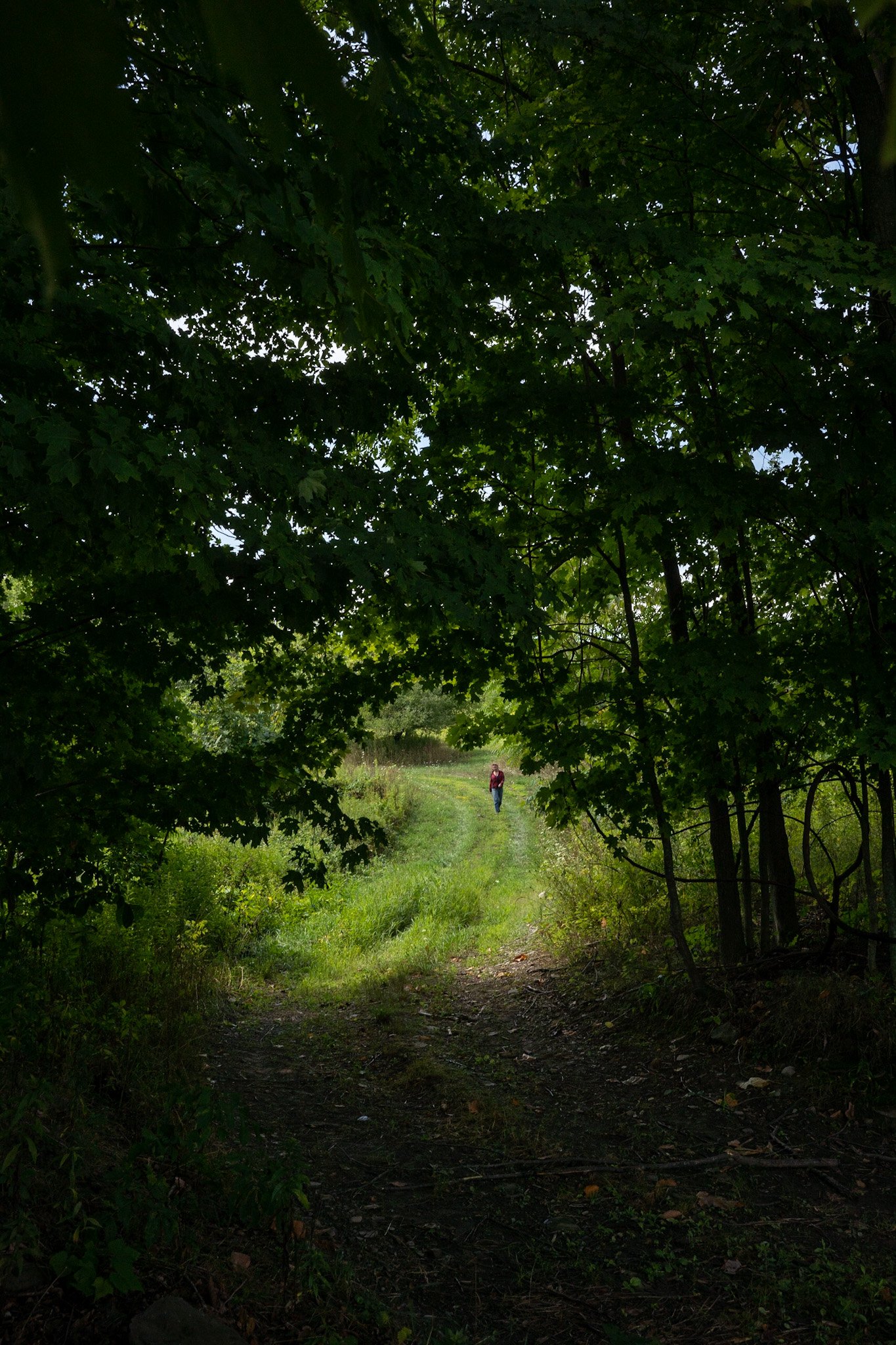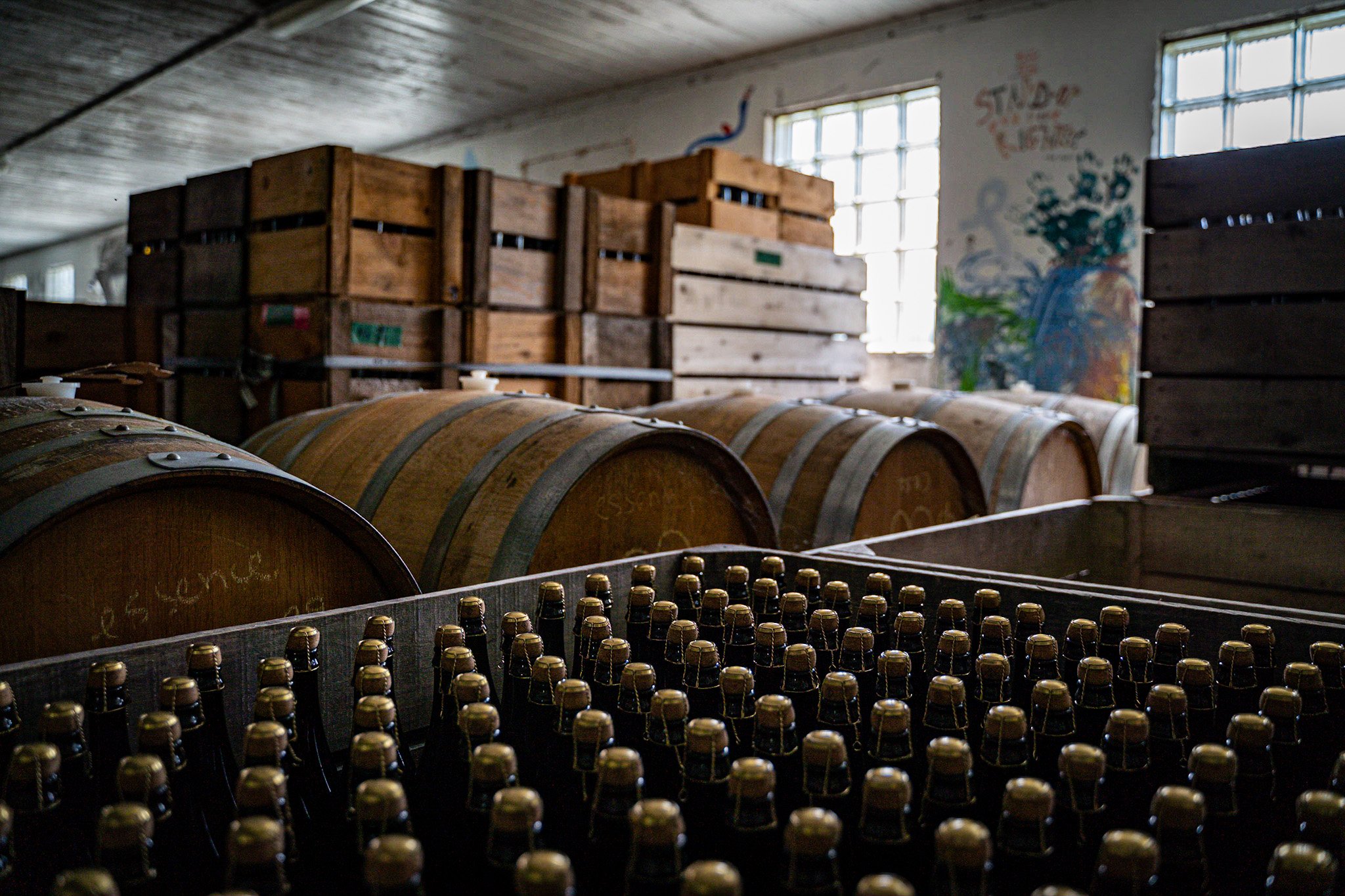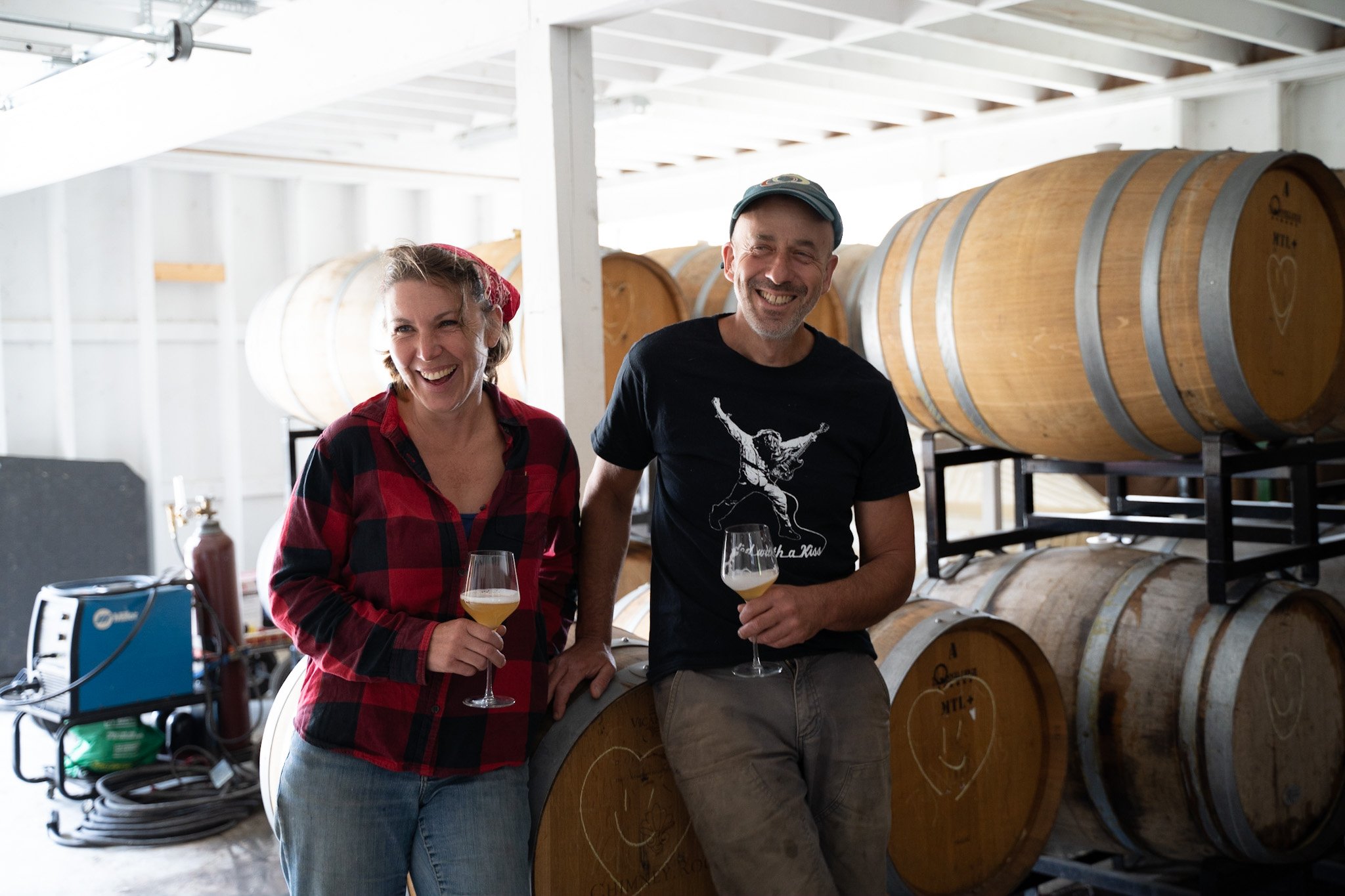Some Stones From Underneath — Eve’s Cidery in Van Etten, New York
I’m standing on top of a steep, south-facing, shale-scaled hill in the northern wilderness of New York State. Above my head a juvenile bald eagle whirls and stoops through the blue. Across the valley the sheer face of a glacier-carved ridge rises up like the crest of a wave. And beneath me, fenced off from greedy, marauding deer, clinging to the slope like children to a parent’s legs, are apple trees with names from across the ocean.
Photography by Melissa Jones
I close my eyes for a moment, open them again, and the wild hills roll back—I’m not in New York State at all, but at home in my Reading flat with a cold glass of Eve’s Cidery Albee Hill in my hand.
Alive with aromatic blood orange, vibrant strawberry, complex citrus peels, spice and petrichor, it is, by common consensus among cider devotees, one of the world’s greats; a masterclass of apple fruit. But there’s more to it than that.
***
Where does the flavour of cider come from? The obvious answer is the fruit: the apples; the ingredient. But for Autumn Stoscheck and Ezra Sherman, owners of Eve’s Cidery in Van Etten, upstate New York, it goes further.
The mission statement on their website is as enigmatic as it is intriguing: “The primary impulse behind our cider making is to find an answer to the question: Can you taste a place?”
“If any cider captures a sense of place, Eve’s would be a prime example,” Matt Windle of the US-based Cider Exchange tells me by email. “If you take a sip you can see the lakes, the hills, and hollows of the region.”
I had never visited. My picture of Eve’s was painted wholly from shared bottles and snatched tastes. Uniformly delicious, elegant, startling in their vividness of fruit. But how were their flavours bound to those hills and hollows?
To answer this question I find myself at their cidery in the Finger Lakes talking about glaciers.
“There’s a multitude of geological forces that have shaped what you see here,” Autumn tells me. “But the glaciers are probably the most dominant.”
10,000 years ago the glaciers rolled down from the iron-cold north. They were stopped by a raised piece of land and as their dammed ice churned and raged against it they kicked up long, slender grooves, which would later fill with water and become the Finger Lakes. Finally bursting through, the glaciers hacked out a network of oversteepened valleys and dumped glacial sediment on the floor in their wake.
“One of the things that I think is fun and interesting about this site is that we have an orchard down here in the glacial material,” says Autumn. “It has a very high nutrient capacity, but it’s very, very dry and very, very deep. Then the orchard on the hillside is in silt that’s the native rock material. So it’s shale that has weathered for millions of years.”
““If any cider captures a sense of place, Eve’s would be a prime example. If you take a sip you can see the lakes, the hills, and hollows of the region.””
The team at Eve’s is still finding out precisely what this means for the apples, and the cider. The dry conditions of the glacial valley could mean higher sugars and alcohol, bigger flavours and body, while the ancient shale could be a conduit for minerality, and acidity. As yet, there are no certainties. Autumn’s working on it.
Autumn arrived ten millennia after the glaciers. She’d been waiting tables and working on orchards whilst on a leave of absence from college when she read of Farnum Hill Ciders’ Steve Wood grafting English bittersweet cider apples in his New Hampshire orchards.
“That just blew my mind,” Autumn says. “I had never heard of such a thing. So I got in my car and I drove up there.”
On Steve’s advice she travelled to England, learning cidermaking and visiting orchards; it was there that a notion of the Finger Lakes as a cider region really crystallised in Autumn’s mind. Using her savings she bought equipment, planted apple trees grafted with cider variety scion wood, and launched Eve’s in 2001.
***
To say that Eve’s has had an impact on both the local cider scene and the broader international picture since would be a huge understatement.
“It was like ‘wow, what is this cider?’” cider writer, author, and educator Gabe Cook says of his first taste of their creations. “Textural, aromatic, perfectly-poised acidity, stone fruit-iness. I love everything that they do. Every single one of their ciders is sublime. There’s no other way of saying it.”
Despite her original inspiration, Autumn is clear that there is more to expressing a place than simply growing apples there, emphasising the importance of organic, regenerative farming.
“It’s not just us telling you ‘we don’t spray synthetic chemicals’,” she explains. “We get inspected, we pay fees, we keep records, we’re accountable. That’s what it means on the surface level.”
But it goes beyond that surface. Autumn talks of revitalising the soil: the idea that cider isn’t simply sugar and acid and tannin, but that the minerals in healthy soil tangibly contribute to flavour too.
““I don’t know peoples’ names and I’m not good with faces, but I know apple varieties.””
“When you have really shallow-rooted plants growing in dead soil, they’re not actually interacting with that soil,” she says. “So I think not only is the quality of the cider reduced but the tree’s immune system is reduced. That’s a downward spiral.”
This sort of farming, without herbicides or pesticides, necessarily creates more labour-intensive work. There’s competition from weeds and the heightened risk of pests. The north-east of the United States, Autumn says, is a particularly “disease rich” area. But the Eve’s team are convinced that it is by returning life and vigour to the land that they are able to best nourish their trees, and in turn gather the most flavoursome apples.
By comparison with some this side of the Atlantic, the Eve’s orchards are relatively young. The oldest trees that Autumn planted herself are just entering their third decade, though she harvests from some orchards more advanced in years.
“I think older trees make better cider,” she admits. “They have much more well-established mychorrizal—fungal—connections, they have deeper roots, there’s more soil surface area that they’re in contact with.”
To prove it, she has me taste two single variety Golden Russets. Both still, dry, wild fermented, both from the same vintage. But one made with fruit from North Orchard trees, only fifteen years old, and the other with apples harvested from 40-year-old trees in nearby Newfield Orchard.
The difference is profound. Though both are superb, recognisably the same variety, boasting voluptuous texture, pristine orchard fruit and seamless acid structure, there is an unmistakable increase in depth and breadth in the Newfield. An upped intensity and unctuousness; where pears and blossom sprung from the North Orchard, here are melons, honeys and the most gorgeous butter popcorn finish. The evidence in favour of Autumn’s conviction is tangible and compelling.
***
We trudge up the steep slope of Albee Hill, the ridge behind the cidery that gives its name to their flagship bottling. The apple trees slip down it in rows and I struggle to keep up as Autumn whisks me through their myriad varieties.
The classic English apples I know; Brown Snout, Dabinett, Chisel Jersey. But there are American names here too; Northern Spy, Golden Russet, Wickson, Virginia Crab. The latter is already starting to blossom; Autumn tells me it’s one of the earliest varieties.
To her each tree is an old friend. They are tagged, but she knows them by sight. She points out Browns’ distinctive, vertical-shooting twigs; “I don’t know peoples’ names and I’m not good with faces, but I know apple varieties,” she laughs.
Albee Hill was the Eve’s cider that first stole my heart. The blend changes every year according to the varieties that have grown best, but the hallmarks of billowing aromatics, textural elegance, poise, clarity, and slatey minerality always remain.
Again, quizzing Autumn on it, she talks not just about the fruit, but about the orchard; the land.
“It’s a special place,” she says. “And it’s an unlikely place. It’s not rich and fertile. It looks like it, but it’s not like the north Finger Lakes where it’s lower elevation and a softer climate and rich, rich soils. It’s harder. It’s a little crazy that we’re doing it here.”
The climate, too, is more extreme than the south of England’s: colder winters, hotter summers, far more oscillation between wet and dry. Yet there are benefits to this toughness.
“One of the things about here is that the [autumns] are really conducive to high-sugar, high-acid fruit,” says Autumn. “It gets really clear and sunny and warm during the day—not hot—and cold at night, and that pattern allows the acid to develop as the apples are ripening, as the sugars are increasing. That’s something really special about the Finger Lakes; that we grow really bright, high-acid fruit.”
I think of the vivid, technicolour flavours of Albee Hill’s eponymous bottling and reflect on how often the most challenging and marginal of places produce the most characterful and compelling of drinks.
“We have so many conscientious, land-oriented people making cider in the Finger Lakes,” Meredith Collins, perhaps America’s leading cider blogger, tells me. “Eve’s are absolutely part of that. That holistic view of making cider considers everything and can work with the natural variations of the seasons. I love how that comes through in the cider.”
***
There is an emptiness to this land in the south of the Finger Lakes—a keening, abandoned loneliness. This area was once home to the native Haudenosaunee Confederacy until they were violently dispossessed of it by European settlers.
“George Washington charged General Sullivan with a campaign of genocide in 1779,” Autumn explains. “They came through with a scorched earth campaign which included burning 50 villages, 1500 houses, millions of bushels of corn and girdling thousands of apple trees. And they did it all in September before a very, very harsh winter. So the people fled, the British didn’t give them any food; they starved to death in camps up in Canada. And white people just moved in.”
Along with other Finger Lakes cideries such as Redbyrd, further north, Eve’s is committed to supporting the Haudenosaunee’s efforts at land and seed rematriation—the reclamation of lost and stolen lands, seeds and food by their original communities—through financial contributions and shared resources. Autumn also emphasises the importance of normalising discussion of America’s deliberately overwritten and colonial history.
“I think that part of the story is just making it part of our everyday lives,” she explains. “For us that means making meaningful financial contributions or any other way that we have some sort of resource that we can offer, whether it’s some type of social capital or networking abilities, money, equipment, stuff like that.”
“I’m not saying that we have the answer or ‘oh we’re so great because we’re doing something right,’” she continues, “but I think it’s at least something that I hope people will think about: ‘how will I build this into my business?’”
***
We wander back down the slope of Albee Hill and drift through the barrels and ordered chaos of the small cidery, trailed by a friendly cat, Autumn pointing out new bottlings and pieces of equipment as we go. Eve’s range is mesmerising; everything from naturally sparkling pét nats to the creamy indulgence of twice-fermented champagne methods, and even the deep, booming richness of fortified pommeau—apple juice blended with cider brandy. Another taste of the land in each one.
Eve’s have changed their outlook since the pandemic. Their old business model heavily skewed towards restaurants, and their subsequent pivot towards mainly online retail was aided by the introduction of a cider club.
“That’s been really amazing for us”, says Autumn. “Because the amount of people that we have in the club right now means that if I make a barrel, it’s sold.”
Nevertheless, she emphasises the importance of fine, natural cider retaining a place at the restaurant table. “There’s no amount of work you could do convincing somebody that this is actually good that could be the equivalent of being on [a top restaurant’s] wine list.”
Perhaps that’s appropriate. After all, cider may not be wine. It may be entirely its own thing; magnificent, individual, distinct, with its own stories, challenges, joys, and flavours. But with that glass of Albee Hill in hand, it is language borrowed from wine that rises most instinctively in my mind.
This is a drink that speaks of its home. Not just a gaggle of flavours and textures. Not something that can be reduced to the simplicity of a tasting note.
Locked in its golden hues is the unique alchemy of terroir; of the magic conjured only when apples, trees and the land entwine through the sensitivity of a maker who cares enough to nurture them into their most eloquent expression. That sad, wild, ancient, beautiful place decanted into a glass.





